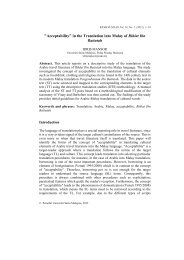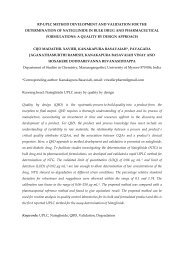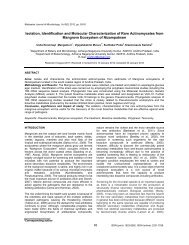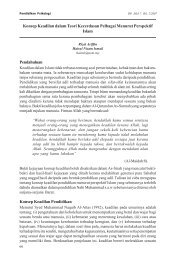Mechanical Strength of Trass as Supplementary Cementing ... - USM
Mechanical Strength of Trass as Supplementary Cementing ... - USM
Mechanical Strength of Trass as Supplementary Cementing ... - USM
Create successful ePaper yourself
Turn your PDF publications into a flip-book with our unique Google optimized e-Paper software.
Journal <strong>of</strong> Physical Science, Vol. 19(2), 51–59, 2008 51<br />
<strong>Mechanical</strong> <strong>Strength</strong> <strong>of</strong> <strong>Tr<strong>as</strong>s</strong> <strong>as</strong> <strong>Supplementary</strong> <strong>Cementing</strong> Material<br />
V. Indrawati * and A. Manaf<br />
Universit<strong>as</strong> Indonesia, Postgraduate Program <strong>of</strong> Materials Science,<br />
Kampus UI, Jl. Salemba Raya No. 4, Jakarta 10430, Indonesia<br />
*Corresponding author: vera.indrawati@ui.edu, vera.indrawati@indocement.co.id<br />
Abstract: The suitability <strong>of</strong> tr<strong>as</strong>s in Indonesia <strong>as</strong> a supplementary cementing material<br />
w<strong>as</strong> investigated and studied. <strong>Mechanical</strong> properties <strong>of</strong> pozzolanic–lime obtained from<br />
tr<strong>as</strong>s reacting with lime were evaluated according to procedure ASTM C-593.<br />
Compressive strength <strong>of</strong> mortar w<strong>as</strong> me<strong>as</strong>ured at ages <strong>of</strong> 2, 3, 7, 14 and 28 days. In<br />
addition to the compressive strength, pozzolanic reaction <strong>of</strong> tr<strong>as</strong>s and lime w<strong>as</strong> also<br />
evaluated by Thermal Activity Me<strong>as</strong>urement (TAM) Air Calorimeter. Results showed that<br />
incre<strong>as</strong>ing <strong>of</strong> fineness until 9000 Blaine resulted strength <strong>of</strong> 60 kg cm –2 at age <strong>of</strong> 2 days.<br />
Further incre<strong>as</strong>e in compressive strength <strong>of</strong> 90 kg cm –2 at the age <strong>of</strong> 2 days w<strong>as</strong> obtained<br />
by the addition <strong>of</strong> 2.71 wt. % Na2SO4. Results <strong>of</strong> TAM Air Calorimeter <strong>of</strong> pozzolanic<br />
reaction showed that heat rele<strong>as</strong>ed followed a linear and exponential correlations for<br />
incre<strong>as</strong>ing fineness and addition <strong>of</strong> Na2SO4, respectively.<br />
Keywords: tr<strong>as</strong>s, pozzolanic reaction, supplementary cementing material<br />
1. INTRODUCTION<br />
Nowadays, pozzolanic materials are widely used <strong>as</strong> supplementary<br />
cementing material in Portland cements and may replace part <strong>of</strong> the clinker in<br />
order to enhance the performance <strong>of</strong> the hydrated cement. Such composite or<br />
blended cements are employed for their economic, ecological and technological<br />
benefits. Energy consumption <strong>as</strong> well <strong>as</strong> CO2 emission is reduced. <strong>Supplementary</strong><br />
cementing materials reduce lime content in hydrated Portland cements and<br />
replace it with pore-filling cement hydrates, which are known to improve the<br />
ultimate strength, impermeability and durability to chemical attack <strong>of</strong> cement. 1<br />
Different types <strong>of</strong> additions are used such <strong>as</strong> pozzolanic (natural pozzolan, low<br />
calcium fly <strong>as</strong>h and silica fume), auto pozzolanic (high calcium fly <strong>as</strong>h and bl<strong>as</strong>t<br />
furnace slag) and crystalline (generally known <strong>as</strong> filler). Pozzolanic activity or<br />
hydraulicity <strong>of</strong> pozzolanic material is mainly <strong>as</strong>sociated with their vitreous and/or<br />
amorphous structure. 2<br />
The slow chemical reaction between pozzolan and calcium hydroxide,<br />
lime (CH) in water (H) is called the pozzolanic and leads to the formation <strong>of</strong><br />
calcium silicates (C-S-H) and calcium aluminate hydrates (C-A-H). However, the<br />
C-A-H usually have higher crystallinity and their composition is usually e<strong>as</strong>ier to
<strong>Mechanical</strong> <strong>Strength</strong> <strong>of</strong> <strong>Tr<strong>as</strong>s</strong> 52<br />
determine than the composition <strong>of</strong> C-S-H. Because pozzolan are usually low in<br />
CaO, this component must be added in stoichiometric quantity and added <strong>as</strong> lime<br />
or, in composite cement, provided by the lime formed during cement hydration.<br />
The consumption <strong>of</strong> lime, followed by the precipitation <strong>of</strong> hydrated cement<br />
minerals with lower density is very efficient in filling up capillary pore space<br />
thereby decre<strong>as</strong>ing porosity. This lime consuming process and the <strong>as</strong>sociated<br />
pore refinement process lead to incre<strong>as</strong>e strength, impermeability, durability and<br />
chemical resistance <strong>of</strong> pozzolan cement. 1<br />
<strong>Mechanical</strong> activation is a mechanical physical method to improve the<br />
degree <strong>of</strong> fineness through method <strong>of</strong> pulverization, and thus incre<strong>as</strong>e the surface<br />
area and surface energy greatly so <strong>as</strong> to enhance volcanic <strong>as</strong>h reaction activity.<br />
There are many reports about this subject. Pulverization breaks the vitreous body<br />
and incre<strong>as</strong>es their surface, resulting in higher activity. 3<br />
Chemical activation is widely used to excite the activity <strong>of</strong> pulverized<br />
fuel <strong>as</strong>h. Chemicals used may include alkaline reagents such <strong>as</strong> Ca(OH)2 and<br />
NaOH 4 which can break the Si-O and Al-O in the vitreous body <strong>of</strong> pulverized<br />
<strong>as</strong>h, and accelerate the dissolution <strong>of</strong> Si 4+ and Al 3+ . Other chemicals are alkali<br />
salts such <strong>as</strong> silicates, sulfate and carbonates. The hydrate <strong>of</strong> NaSiO3 could<br />
maintain the concentration <strong>of</strong> alkali in solution, but when it loses water, its<br />
product in the form <strong>of</strong> silica gel would change to gel having solid properties. This<br />
gelatinization is the process <strong>of</strong> transformation from linear to reticular structure.<br />
CaSO4 and Na2SO4 are sulfates, which in alkaline condition reacts with Al2O3 to<br />
produce hydrated calcium sulfate crystal. The continuous reaction accelerates the<br />
hydration <strong>of</strong> pulverized fuel <strong>as</strong>h which makes the activity fully exploited. 4<br />
Study on activation <strong>of</strong> slag indicates that the commonly used activators<br />
are sulfates, sodium silicate, calcium hydroxide, and in rare caustic soda. The<br />
majority <strong>of</strong> these activators contain alkali metal (e.g. Li, Na, K) so they are called<br />
alkali activators. The activator will accelerate the strength development and<br />
incre<strong>as</strong>e the 28 days strength. Some <strong>of</strong> the activators can be taken simply <strong>as</strong><br />
catalyst, because they are highly soluble and can hardly react with the oxides in<br />
slag to form solid products. NaOH solution is a typical example. 3<br />
Other study on natural pozzolan-lime system showed that Na2SO4 is<br />
more effective <strong>as</strong> an activator compared to Na2CO3, NaOH, CaCl2.2H2O and<br />
ordinary Portland cement clinker. Addition <strong>of</strong> 6% Na2SO4 in the system <strong>of</strong><br />
lime:pozzolan ratio 30%:70% incre<strong>as</strong>ed the compressive strength <strong>of</strong> two folds<br />
compared with the mixture without pozzolan at the age <strong>of</strong> 90 days. Morphology<br />
<strong>of</strong> the p<strong>as</strong>te showed the similar porosity <strong>as</strong> the cement p<strong>as</strong>te without activator at<br />
the age <strong>of</strong> 50 days. 6
Journal <strong>of</strong> Physical Science, Vol. 19(2), 51–59, 2008 53<br />
In this paper, preliminary study on natural pozzolan in Indonesia, tr<strong>as</strong>s<br />
w<strong>as</strong> performed to identify the reactivity in relation to mechanical strength gained<br />
by mechanical and chemical activation treatment.<br />
2. EXPERIMENTAL<br />
Chemical compositions and mineralogy <strong>of</strong> 65 samples <strong>of</strong> tr<strong>as</strong>s from<br />
various deposits in Java Island, Indonesia were investigated by X-Ray<br />
fluorescence and diffraction method. One sample w<strong>as</strong> selected to determine its<br />
activity <strong>as</strong> supplementary cementing material. Activation w<strong>as</strong> carried out by<br />
pulverizing the sample to finer particles and addition <strong>of</strong> inorganic salt, Na2SO4 <strong>as</strong><br />
chemical activator.<br />
Pulverization w<strong>as</strong> performed by grinding sample into various particle<br />
size distributions represented by the specific surface area, Blaine. Particle size<br />
distribution w<strong>as</strong> me<strong>as</strong>ured by Malvern, L<strong>as</strong>er Particle Size Analyzer. In<br />
accordance with the standard specification for pozzolanic materials, ASTM C-<br />
593, pozzolans for supplementary cementing material, shall have minimum 66%<br />
<strong>of</strong> particle size less than 45 μm or 34% retained on 45 μm sieve.<br />
In this experiment, particle sizes <strong>of</strong> tr<strong>as</strong>s were varied from 2462 until<br />
9100 cm 2 g –1 Blaine, but activation by Na2SO4 applied only to the extreme low<br />
and high Blaine samples. Dosage <strong>of</strong> 2.71 wt. % Na2SO4 by weight <strong>of</strong> binder w<strong>as</strong><br />
used and applied to both coarse and fine samples.<br />
To me<strong>as</strong>ure the mechanical strength gained, tr<strong>as</strong>s samples mixed with<br />
lime (tr<strong>as</strong>s:lime = 70%:30%) to form slurries with water/binder ratio <strong>of</strong> 0.62, the<br />
ratio which slurry is workable. Slurries then poured into cubes mould <strong>of</strong> 4 x 4 x 4<br />
cm, referring to procedure in ASTM C-593. For me<strong>as</strong>urements at ages <strong>of</strong> 2, 3, 7,<br />
14 and 28 days, each 3 cubes were prepared making the total <strong>of</strong> 15. Cubes were<br />
cured for 7 days in moist cabinet with relative humidity <strong>of</strong> 50% and temperature<br />
<strong>of</strong> 50 o C. After 7 days, the cubes were then moved to a moist cabinet <strong>of</strong> 23 o C and<br />
kept for 28 days. On each age <strong>of</strong> curing, compressive strength <strong>of</strong> cube w<strong>as</strong><br />
me<strong>as</strong>ured.<br />
Pozzolanic reaction w<strong>as</strong> monitored by TAM Air Calorimeter. Heat<br />
rele<strong>as</strong>ed during reaction <strong>of</strong> tr<strong>as</strong>s–lime system w<strong>as</strong> me<strong>as</strong>ured <strong>as</strong> heat flow in mW<br />
and converted to J g –1 .
<strong>Mechanical</strong> <strong>Strength</strong> <strong>of</strong> <strong>Tr<strong>as</strong>s</strong> 54<br />
3. RESULTS AND DISCUSSION<br />
3.1 Typical Oxides and Mineral Compositions <strong>of</strong> <strong>Tr<strong>as</strong>s</strong><br />
<strong>Tr<strong>as</strong>s</strong> is an alumino silicates compound with major oxides SiO2, Al2O3,<br />
Fe2O3 and some others CaO, K2O, Na2O in minor amounts. While the oxide<br />
composition <strong>of</strong> tr<strong>as</strong>s can vary from one deposit to another, the tr<strong>as</strong>s from one<br />
deposit remains relatively consistent. Chemical compositions <strong>of</strong> a number <strong>of</strong> tr<strong>as</strong>s<br />
samples from various locations in Java Island, Indonesia, consisting <strong>of</strong> 65<br />
samples, are shown in Table 1 showing SiO2 and Al2O3 <strong>as</strong> main oxides.<br />
<strong>Tr<strong>as</strong>s</strong> suitable for cement production mainly contains gl<strong>as</strong>sy ph<strong>as</strong>e<br />
silicates, while Portland cement generally contains crystalline calcium silicates.<br />
The high gl<strong>as</strong>sy ph<strong>as</strong>e silicates content and its met<strong>as</strong>table nature are the important<br />
source <strong>of</strong> activation energy during its hydration. However, tr<strong>as</strong>s <strong>as</strong> natural<br />
pozzolan mainly contains crystalline minerals which are inactive. Mineral<br />
compositions <strong>of</strong> samples in this experiment contain mineral groups <strong>of</strong> feldspar<br />
and kaolinite. Typical crystalline minerals found in tr<strong>as</strong>s sample are listed in<br />
Table 2. The gl<strong>as</strong>sy ph<strong>as</strong>e content is not determined and discussed in this<br />
experiment.<br />
Table 1: Chemical compositions <strong>of</strong> 65 tr<strong>as</strong>s samples from Java Island, Indonesia.<br />
Oxides (%) Mean Minimum Maximum<br />
SiO2 59.65 48.13 74.93<br />
Al2O3 20.64 13.88 28.86<br />
Fe2O3 5.51 0.57 10.78<br />
CaO 3.32 0.46 7.23<br />
MgO 1.02 0.11 3.11<br />
SO3 0.15 0.00 4.27<br />
Na2O 1.5 0.00 3.8<br />
K2O 1.64 0.01 4.40<br />
Table 2: Possible crystalline minerals in tr<strong>as</strong>s <strong>of</strong> Java Island, Indonesia.<br />
Main components Minor components Seldom components<br />
Andesine Microline Biotite<br />
Quartz Kaolinite Analcime<br />
Montmorillonite Anorthite
Journal <strong>of</strong> Physical Science, Vol. 19(2), 51–59, 2008 55<br />
3.2 Effect <strong>of</strong> Fineness and Addition <strong>of</strong> Inorganic Salt Na2SO4 to<br />
Compressive <strong>Strength</strong><br />
Pulverized tr<strong>as</strong>s samples with the specific surface area, Blaine cm 2 g –1 is<br />
shown in Figure 1. In this experiment, only samples with Blaine above<br />
4500 cm 2 g –1 have 66% <strong>of</strong> particle sizes <strong>of</strong> less than 45 μm, <strong>as</strong> governed by the<br />
standard. Pulverized tr<strong>as</strong>s at this fineness can be used <strong>as</strong> supplementary<br />
cementing material requiring no further activation.<br />
Compressive strength obtained is shown in Figures 2 and 3. Figure 2<br />
shows the effect <strong>of</strong> mechanical activation, where sample with low fineness <strong>of</strong><br />
2462 cm 2 g –1 Blaine gives very low strength <strong>of</strong> 17 to 21 kg cm 2 at the ages <strong>of</strong> 2 to<br />
28 days. Sample with high fineness <strong>of</strong> 9190 cm 2 g –1 Blaine (100% <strong>of</strong> particle sizes<br />
less than 45 μm) gives 60 kg cm –2 strength at 2 days and incre<strong>as</strong>ing to 80 kg cm –2<br />
at 28 days age.<br />
The addition <strong>of</strong> Na2SO4 <strong>of</strong> 2.71 wt. % <strong>as</strong> activator shown in Figure 3.<br />
<strong>Tr<strong>as</strong>s</strong> sample <strong>of</strong> 2462 cm 2 g –1 Blaine gained strength <strong>of</strong> 42 kg cm –2 at 2 days age<br />
but not incre<strong>as</strong>ing up to 28 days. <strong>Tr<strong>as</strong>s</strong> sample <strong>of</strong> 9190 cm 2 g –1 Blaine showed<br />
tremendous incre<strong>as</strong>e in strength. <strong>Strength</strong> <strong>of</strong> 90 kg cm –2 w<strong>as</strong> gained at 2 days age<br />
and reaching 110 kg cm –2 at 28 days.<br />
3.3 Heat Rele<strong>as</strong>e <strong>of</strong> <strong>Tr<strong>as</strong>s</strong>–Lime Reaction<br />
Monitoring the pozzolanic reaction occurred between tr<strong>as</strong>s and lime w<strong>as</strong><br />
shown in Figures 4 and 5. Figure 4 shows reaction occurred spontaneously after<br />
the material mixed. Heat rele<strong>as</strong>ed during the reaction incre<strong>as</strong>es <strong>as</strong> the reaction<br />
continued. Finer particles showed higher heat rele<strong>as</strong>ed, which means reaction<br />
occurred at a higher portion. This w<strong>as</strong> also proven by higher strength gained at<br />
higher fineness <strong>as</strong> described above. Monitoring w<strong>as</strong> performed up to 7 days and<br />
showed an incre<strong>as</strong>e <strong>of</strong> heat rele<strong>as</strong>ed. Maximum heat rele<strong>as</strong>ed by system with<br />
8218 cm 2 g –1 Blaine and achieved about 30 J g –1 at 160 h.<br />
Addition <strong>of</strong> chemical activator Na2SO4 at 2.71 wt. % showed higher heat<br />
rele<strong>as</strong>e compare to the one without activator <strong>as</strong> shown in Figure 5. This proved<br />
that Na2SO4 worked <strong>as</strong> activator to accelerate the reaction between lime and<br />
tr<strong>as</strong>s. 6 About 60 J g –1 heat w<strong>as</strong> rele<strong>as</strong>ed during the hydration <strong>of</strong> mix 9190 cm 2 g –1<br />
Blaine with addition <strong>of</strong> Na2SO4.<br />
Figure 6 shows an equation <strong>as</strong> an approach to the model reaction <strong>of</strong><br />
tr<strong>as</strong>s–lime system. <strong>Mechanical</strong> activation showed a linear correlation at a very<br />
moderate coefficient which means the value is almost fixed. This data is<br />
supported by trend <strong>of</strong> compressive strength gain in mechanical activation. On the
Percentage (%)<br />
Compressive strength (kg cm –2 )<br />
60<br />
50<br />
40<br />
30<br />
20<br />
10<br />
0<br />
0-5 5-10 10-15 15-20 20-25 25-30 30-35 35-40 40-45 45-50<br />
Figure 1: Particle size distribution pulverized tr<strong>as</strong>s from Blaine 2462 to 9354 cm 2 g –1 .<br />
120<br />
110<br />
100<br />
90<br />
\<br />
80<br />
70<br />
60<br />
50<br />
40<br />
30<br />
20<br />
10<br />
0<br />
9190 cm 2 g –1<br />
2462 cm 2 g –1<br />
Particle Size (micron)<br />
2 3 7 14 28<br />
Curing time (days)<br />
2452<br />
4083<br />
5344<br />
6746<br />
8218<br />
9354<br />
Figure 2: Compressive strength <strong>of</strong> tr<strong>as</strong>s–lime system <strong>as</strong> function <strong>of</strong> tr<strong>as</strong>s finenesses.
Compressive strength (kg cm –2 )<br />
120<br />
110<br />
100<br />
90 \<br />
80<br />
70<br />
60<br />
50<br />
40<br />
30<br />
20<br />
10<br />
0<br />
9190 cm 2 g –1<br />
2462 cm 2<br />
2 3 7 14 28<br />
Curing time (days)<br />
Figure 3: Compressive strength <strong>of</strong> tr<strong>as</strong>s–lime system using 2.71 wt. % Na2SO4 <strong>as</strong><br />
activator.<br />
Normalized Heat (J g –1 )<br />
40<br />
35<br />
30<br />
20<br />
25<br />
15<br />
10<br />
5<br />
0<br />
0 24 48 72 96 120 144 168<br />
Hydration time (h)<br />
2462<br />
5344 8218<br />
Figure 4: Heat rele<strong>as</strong>e <strong>of</strong> pulverized tr<strong>as</strong>s–lime reaction <strong>as</strong> function <strong>of</strong> time.
Normalized Heat (J g –1 )<br />
70<br />
60<br />
50<br />
40<br />
30<br />
20<br />
10<br />
0<br />
0 24 48 72 96 120 144 168<br />
Hydration time (h)<br />
8218 5344 2462<br />
Figure 5: Heat rele<strong>as</strong>e <strong>of</strong> tr<strong>as</strong>s–lime reaction with addition <strong>of</strong> 2.71 wt. % Na2SO4 on<br />
different finenesses <strong>of</strong> tr<strong>as</strong>s.<br />
Normalized Heat (J g –1 )<br />
70<br />
60<br />
50<br />
40<br />
30<br />
20<br />
10<br />
0<br />
0 24 48 72 96 120 144 168<br />
Hydration time (h)<br />
Figure 6: Linear and exponential correlations <strong>of</strong> heat flow versus hydration time for<br />
different mixture.
Journal <strong>of</strong> Physical Science, Vol. 19(2), 51–59, 2008 59<br />
other hand, samples treated by Na2SO4 showed an exponential correlation, with<br />
the exception <strong>of</strong> sample at low Blaine. This also supported by strength<br />
development from 2 up to 28 days <strong>of</strong> samples with high Blaine treated by<br />
chemical activation.<br />
4. CONCLUSION<br />
<strong>Mechanical</strong> strength gained from the mechanical and chemical<br />
activations <strong>of</strong> tr<strong>as</strong>s explains and proves that tr<strong>as</strong>s could be used <strong>as</strong> a<br />
supplementary cementing material in blended cement. The incre<strong>as</strong>e <strong>of</strong><br />
mechanical strength w<strong>as</strong> also explained by an incre<strong>as</strong>e <strong>of</strong> heat rele<strong>as</strong>ed during<br />
pozzolanic reaction. Exponential correlation between the heat rele<strong>as</strong>e and the<br />
reaction time explains the effective activation <strong>of</strong> tr<strong>as</strong>s by means <strong>of</strong> chemical<br />
activation at finenesses above 2500 cm 2 g –1 Blaine. <strong>Tr<strong>as</strong>s</strong> <strong>of</strong> fineness <strong>of</strong> 9190 cm 2<br />
g –1 Blaine at tr<strong>as</strong>s–lime system (2:1) gives maximum strength <strong>of</strong> 124 kg cm –2 at<br />
28 days with addition <strong>of</strong> 2.71 wt. % Na2SO4.<br />
5. REFERENCES<br />
1. Muller, C.J. (2005). Pozzolanic activity <strong>of</strong> natural clay minerals with<br />
respect to environmental geotechnics. Dissertation, Swiss Federal<br />
Institute <strong>of</strong> Technology Zurich, Switzerland.<br />
2. Rahhal, V. & Talero, R. (2005). Early hydration <strong>of</strong> Portland cement with<br />
crystalline mineral additions. Cement and Concrete Research, 35,<br />
1285–1291.<br />
3. Chen, W. (2007). Hydration <strong>of</strong> slag cement. Ph. D. Thesis, University <strong>of</strong><br />
Twente, Netherland.<br />
4. Bao-min, W. & Li-jiu, W. (2004). Development <strong>of</strong> studies and<br />
applications <strong>of</strong> activation <strong>of</strong> fly <strong>as</strong>h. Proceedings <strong>of</strong> the International<br />
Workshop on Sustainable Development and Concrete Technology,<br />
Beijing, China, 20–21 May, 159–169.<br />
5. Arjunan, P., Silsbee, M.R. & Roy, D.M. (2001). Chemical activation <strong>of</strong><br />
low calcium fly <strong>as</strong>h. Part I : Identification <strong>of</strong> suitable activators and their<br />
dosage. Proceedings <strong>of</strong> the International Ash Utilization Symposium,<br />
Center for Applied Energy Research, University <strong>of</strong> Kentucky, 22–24<br />
October, Paper #105.<br />
6. Allahverdi, A. & Ghorbani, J. (2006). Chemical activation and set<br />
acceleration <strong>of</strong> lime–natural pozzolan cement. Ceramics-Silikaty, 50(4),<br />
193–199.


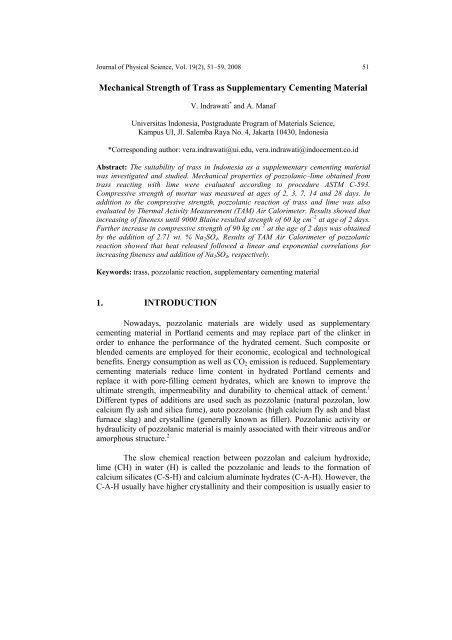

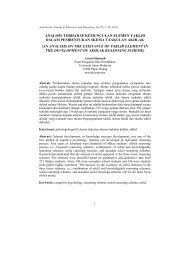
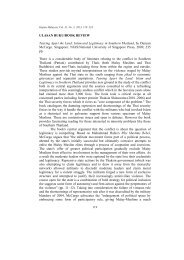

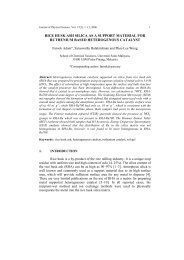

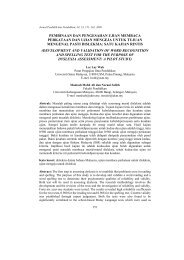
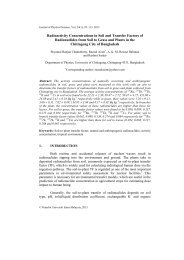
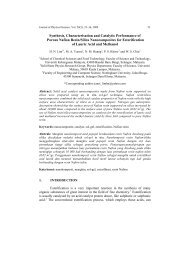

![KTT 111 – Inorganic Chemistry I [Kimia Takorganik I] - USM](https://img.yumpu.com/12405642/1/184x260/ktt-111-inorganic-chemistry-i-kimia-takorganik-i-usm.jpg?quality=85)
